
Avon is a city in Stearns County, Minnesota, United States. The population was 1,396 at the 2010 census. It is part of the St. Cloud Metropolitan Statistical Area.

A crosier or crozier is a stylized staff that is a symbol of the governing office of a bishop or abbot and is carried by high-ranking prelates of Roman Catholic, Eastern Catholic, Eastern Orthodox, Oriental Orthodox, and some Anglican, Lutheran, United Methodist and Pentecostal churches.
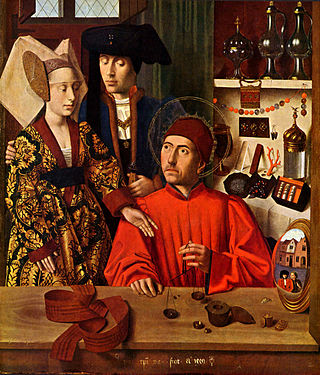
Eligius, venerated as Saint Eligius, was a Frankish goldsmith, courtier and bishop who was chief counsellor to Dagobert I and later Bishop of Noyon–Tournai. His deeds were recorded in Vita Sancti Eligii, written by his friend Audoin of Rouen.
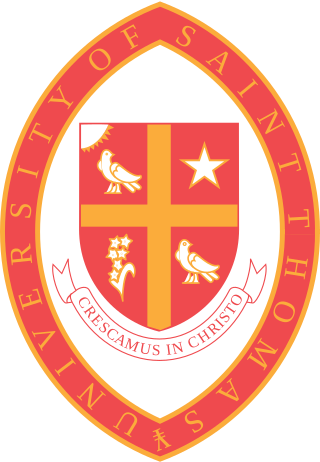
The University of St. Thomas is a private Catholic university in Houston, Texas. It was founded by the Basilian Fathers in 1947 and is the only Catholic university in the Archdiocese of Galveston-Houston.
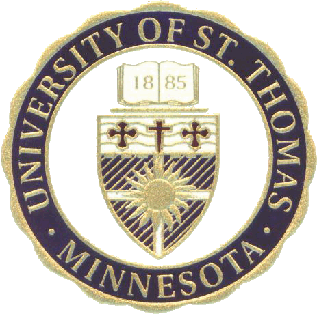
The University of St. Thomas is a private Roman Catholic university in St. Paul and Minneapolis, Minnesota. Founded in 1885 as a Catholic seminary, it is named after Thomas Aquinas, the medieval Catholic theologian and philosopher who is the patron saint of students. As of fall 2021, St. Thomas enrolled 9,347 students, making it Minnesota's largest private, nonprofit university.
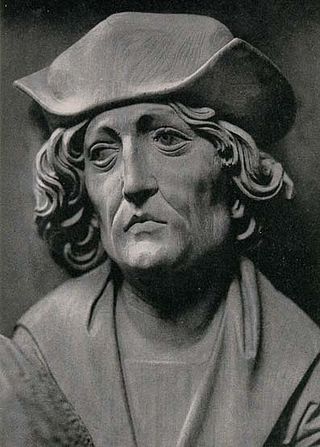
Tilman Riemenschneider was a German sculptor and woodcarver active in Würzburg from 1483. He was one of the most prolific and versatile sculptors of the transition period between late Gothic and Renaissance, a master in stone and limewood.

The University of Santo Tomas (UST), officially the Pontifical and Royal University of Santo Tomas, Manila, is a private, Catholic research university in Manila, Philippines. Founded on April 28, 1611, by Spanish friar Miguel de Benavides, third Archbishop of Manila, it has the oldest extant university charter in Asia and is one of the world's largest Catholic universities in terms of enrollment found on one campus. It is the main campus of the University of Santo Tomas System that is run by the Order of Preachers.

Michael Clark Rockefeller was a member of the Rockefeller family. He was the son of New York Governor and former U.S. Vice President Nelson Rockefeller, a grandson of American financier John D. Rockefeller Jr. and a great-grandson of Standard Oil co-founder John D. Rockefeller Sr.

Tobias Schneebaum was an American artist, anthropologist, and AIDS activist. He is best known for his experiences living and traveling among the Harakmbut people of Peru, and the Asmat people of Papua, Indonesia.

The Asmat are an ethnic group of New Guinea, residing in the province of South Papua, Indonesia. The Asmat inhabit a region on the island's southwestern coast bordering the Arafura Sea, with lands totaling approximately 18,000 km2 (7,336 mi2) and consisting of mangrove, tidal swamp, freshwater swamp, and lowland rainforest.

Alphonsus Augustus Sowada was an American Roman Catholic bishop, cultural anthropologist, and first Bishop of Agats in Indonesia. A longtime collector and preserver of Asmat cultural artifacts, he helped found both the Asmat Museum of Culture and Progress in Agats, and the American Museum of Asmat Art in his home state of Minnesota.
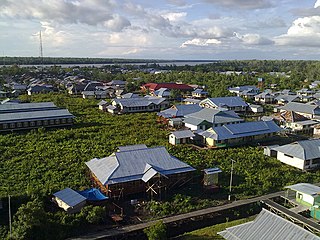
Agats is a town in Asmat Regency, South Papua, Indonesia. An elevated settlement on a tidal plain, a Dutch outpost was set up in Agats in 1938 and the town became notable for the cultural practices of the Asmat people. Following the formation of Asmat Regency in 2002, the town became its administrative seat.

It is quite difficult to define Indonesian art, since the country is immensely diverse. The sprawling archipelago nation consists of 17.000 islands. Around 922 of those permanently inhabited, by over 1,300 ethnic groups, which speak more than 700 living languages.

The American Museum of Asmat Art is a gallery exhibiting the art and culture of the Asmat people of southwestern Papua, Indonesia, housed at the University of St. Thomas in St. Paul, Minnesota. Featuring more than 2,200 objects, it is one of the largest of its kind in the United States. Asmat art is widely collected in major Western museums despite the difficulty in visiting the remote region to collect work; the "exceptionally expressive" art "caused a sensation in art-collecting circles" which led to large-scale collecting expeditions in the post-WWII era, according to art scholar and ethnology Dirk A.M. Smidt. The gallery includes a permanent display of Asmat works such as ancestor poles (bis) and canoes, and a rotating exhibition highlighting aspects of Asmat art and culture. Much of the collection is accessible through the museum's online database.

The German pavilion houses Germany's national representation during the Venice Biennale arts festivals.

Pisuwe is a dagger from the island of New Guinea. Ndam pisuwe or Ndam emak pisuwe are those that are made with human femur bone and Pi pisuwe are for those that are made with Cassowary bone. Prior to the colonization of the Dutch in the 1950s, these daggers are carried by the Asmat people and they are used only in ritual killings. These daggers are usually embellished with Cassowary feathers at the pommel and decorated with carved in artworks depicting humans and animals. Papuan men would wear this dagger as part of their traditional attire during customary ceremonies by girding it on the side of their waist.
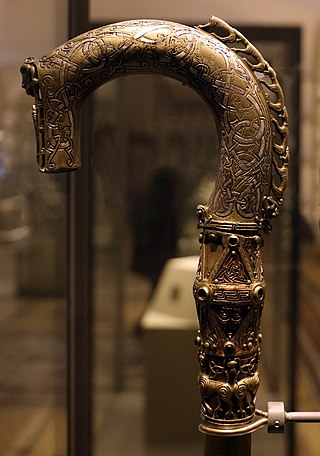
An Insular crozier is a type of processional bishop's staff (crozier) produced in Ireland and Scotland between 800 and 1200. Such items can be distinguished from mainland European types by their curved and open crooks, and drop. By the end of the 12th century, production of Irish croziers had largely ended, but examples continued to be reworked and added to throughout the Romanesque and Gothic periods. Although many of the croziers are associated with 5th- and 6th-century saints, the objects were not made until long after the saints had died. A majority originate from around the 9th century, and were often used as embellishment between the 11th and 13th centuries.
Griffin Murray is an Irish archaeologist and art historian specialising in medieval Ireland and Insular art–especially metalwork–in the period between 400–1550 AD. His interests include identifying and contextualizing the social role of medieval craftsmen, Viking art and the relations between insular and Scandinavian craftsmen, and he is a leading expert on both house-shaped shrines and insular croziers.

The Lismore Crozier is an Irish Insular-type crozier dated to between 1100 and 1113 AD. It consists of a wooden tubular staff lined with copper-alloy plates; embellished with silver, gold, niello and glass; and capped by a crook with a decorative openwork crest.

Apolo Safanpo is an Indonesian academician and bureaucrat who is serving as the Governor of South Papua in an acting capacity since 11 November 2022. He also held office in the Ministry of Home Affairs as the minister's expert staff for governance since 9 November 2022. Before working in the bureaucracy, Apolo was an academician in the Cenderawasih University, with his highest office being the university's rector from 2017 until 2022.























